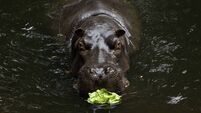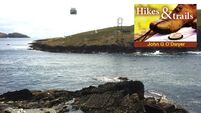Islands of Ireland: Best leave Cull Island to the birds — view it from the mainland

Cull Island Picture: Kevin Higgins, geograph.ie
Islands are few and far between along the County Wexford coast. There are the mighty Saltees of course, currently hosting a throng of puffins (hopefully). Then there is Tuskar Rock, (the scene of the tragic Aer Lingus crash in 1968), and yet to be visited by this columnist, alas. Off Bannow Bay there are a pair of islands, the Keeraghs, scene of a shipwreck in 1914 when nine lifeboat men on the Helen Blake drowned in an attempt to save the crew of the Norwegian schooner, the Mexico.
These islands are just south of the lovely Cullenstown Strand, which brings us neatly to this week’s subject, Cull Island. Stretching between the villages of Cullenstown and Kilmore Quay for about 8km is the magnificent Ballyteige Burrow, a sand-dune system standing about 7m high which protects the mainland from incursions by the sea. It rises and falls like a wave of sand and offers a home to dozens of bird species. Behind the burrow the sea has encroached to make a huge lagoon and in this lagoon at the opposite end to the incursion is found Cull Island. The lagoon fills from the sea in a west to east direction with the tidal range distinct over its length in the few hours it takes to fill.
Cull Island is a small place and unsurprisingly, its main inhabitants are of the avian type. Brent geese, golden plover, lapwing and shelduck frequent the island, often in large numbers. Circular in shape, its four acres are entirely grass-covered with nary a sign of anything manmade, apart from some flotsam and jetsam that washes up.
The entire burrow is a special protection area. “The eastern portion of this intertidal system was reclaimed in the 19th century by construction of the Cull Bank (sea wall) and a pumping station and is now polderland,” stated a report a few years ago by the NPWS. That section is akin to vast swathes of the Netherlands with flat fields, parallel drainage and dykes.
This report also identified flora including marram, Portland spurge, and seaholly on the seaward dunes. The inland dunes have common restharrow, wild pansy, red fescue, and burnet rose, to name a few.
The southeast of Ireland is a major birdwatching location with hundreds of species passing through on migratory routes or even blown off their usual courses as we saw two weeks ago with the north American heron in County Mayo. There have been sightings at Ballyteige Burrow in the last few weeks of rare species including the western cattle egret, Montagu’s harrier and the glossy ibis. And going further back, species such as the European goldfinch, Eurasian skylark and Eurasian kestrel have been observed there.
According to the logainm.ie record the origins of the Cull Island name are somewhat uncertain. “No Modern or Middle English precursor readily suggests itself, and although it is possible that the name may be derived from the Irish coll ‘hazel(-tree)’ … the occurrence of that word as a placename in simplex form would be exceptional.” The placenames database suggests a Norse origin for the word ‘Cull’ possibly deriving from the Norse word kollr ‘a hill’ “as Cull Island sits above the surrounding tidal marsh”.
As we have seen in several instances along the Wexford and Waterford coasts there are several words of Norse origin so this theory is consistent with settlement patterns. Saltee Island comes from ‘Salt Ey’ or Salt Island’’; Helvick Head comes from Hellavík with the suffix referring to ‘bay’, (Smerwick Harbour in County Kerry is also from the Norse). Logainm emphasises that the evidence is scant for this theory, but is possible.
Cullenstown is a townland and village just along the burrow from Cull Island. However, that name derives from Baile Chuilinn. In between, is Cullenstown Strand which was the recent recipient of a Green Coast Award for its excellent water quality. The placename, Cull Island, also occurs at Howth, County Dublin.
: Can be seen from the shore about 2km southeast of the village of Duncormick where a beautiful shoreline walk fringes the lagoon. Best not to visit the island because of nesting birds.
: Birdguides.com; ebird.org; npws.ie; Logainm.ie; visitwexford.ie







